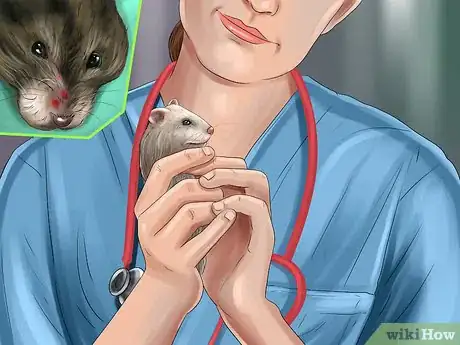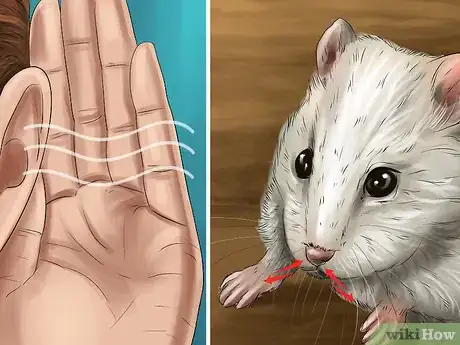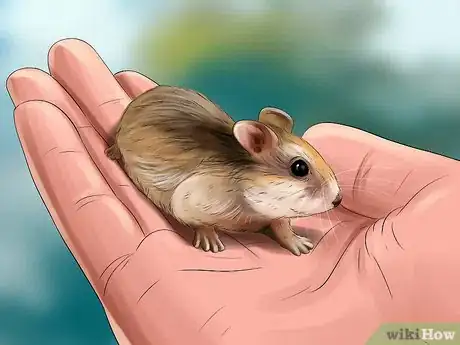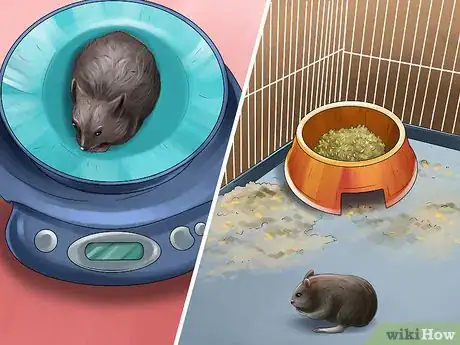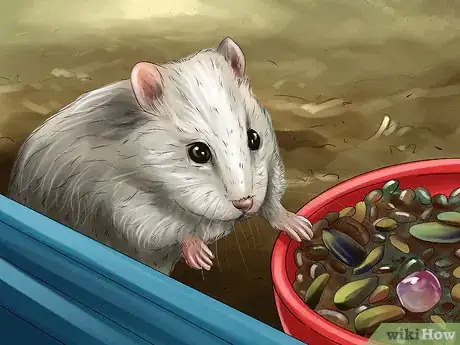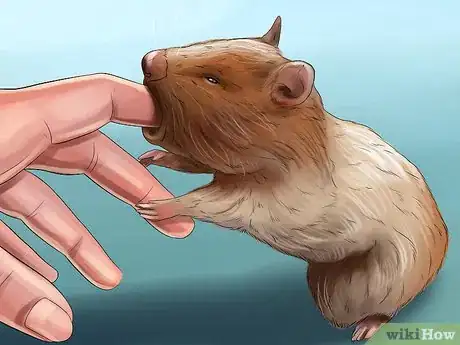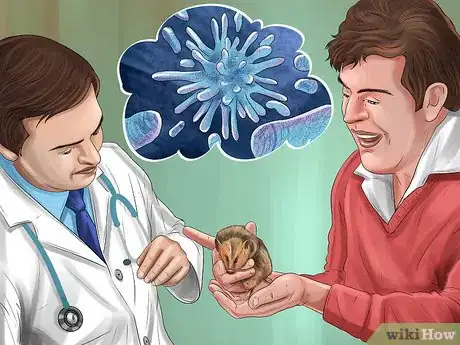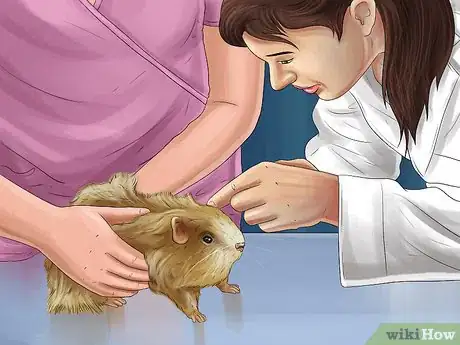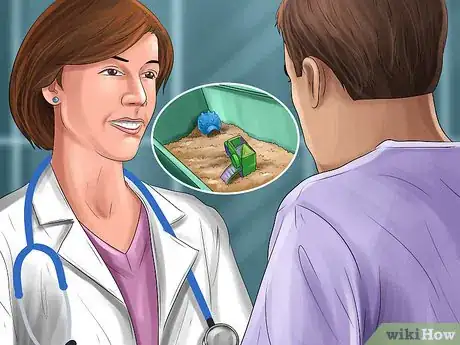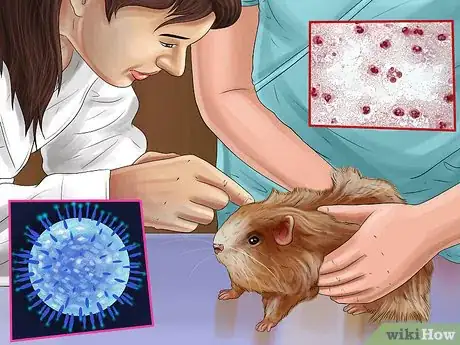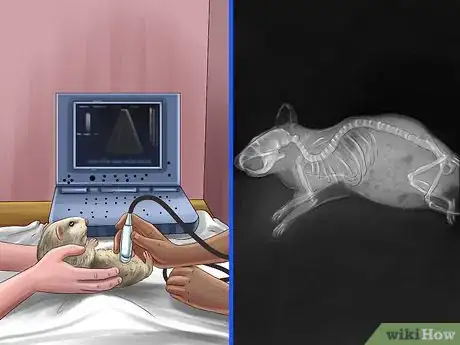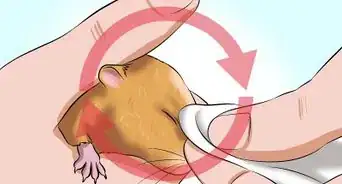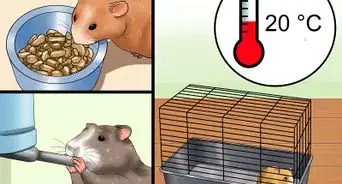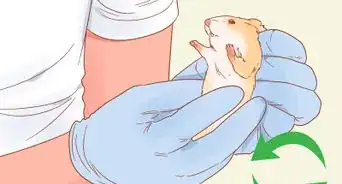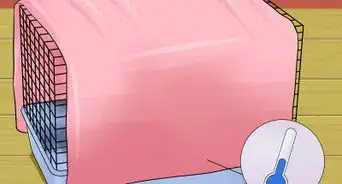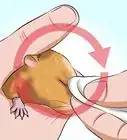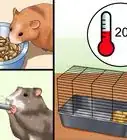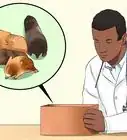This article was co-authored by Pippa Elliott, MRCVS. Dr. Elliott, BVMS, MRCVS is a veterinarian with over 30 years of experience in veterinary surgery and companion animal practice. She graduated from the University of Glasgow in 1987 with a degree in veterinary medicine and surgery. She has worked at the same animal clinic in her hometown for over 20 years.
This article has been viewed 48,514 times.
Hamsters are playful, lively animals that make great pets.[1] In general, they are hardy and healthy.[2] When hamsters do get sick, respiratory illnesses are a common cause.[3] Unfortunately, respiratory illnesses can quickly go from bad to worse in hamsters. The sooner you recognize the signs of illness and get your hamster to your vet, the more quickly it can get treated and start feeling better.
Steps
Observing Physical Symptoms
-
1Check your hamster’s eyes and nose. Respiratory illnesses can cause a variety of symptoms in hamsters. For example, a hamster with respiratory problems may have a thick, mucus-like discharge coming from their eyes and nose.[4] The discharge is opaque or yellow.
- If your hamster has a respiratory illness, its eyes and nose may also look red.
-
2Watch and listen to your hamster breathe. Respiratory illnesses make breathing difficult for hamsters. Your hamster may wheeze when it breathes, causing its chest to visibly widen and contract with each breath.[5] You may be able to hear the wheezing, along with possible rattling or crackling noises, when your hamster breathes.Advertisement
-
3Detect sneezing. If your hamster has a respiratory illness, it may start sneezing.[6] When your hamster sneezes, you may see discharge come out of its nose.
-
4Look at your hamster’s hair coat. A healthy hamster has a shiny hair coat. A hamster with a respiratory illness, though, will have a dull hair coat.[7] If your hamster is sick, its hair coat will lose its natural, healthy sheen.
-
5Observe your hamster’s body condition. In general, hamsters with respiratory illnesses don’t look so good. The sickness will cause your hamster to eat less, leading to weight loss.[8] If your hamster has a respiratory illness, it will look thinner than usual.
-
6Look for shaking and shivering. Hamsters with respiratory illnesses can start to shake and shiver.[9] This may be because they’re feeling cold.
Noticing Behavioral Changes
-
1Determine if your hamster is eating less. A respiratory illness can make your hamster feel so sick that it doesn’t want to eat much anymore.[10] If you’re concerned that your hamster has lost its appetite, measure the amount of food you feed it each day. At the end of the day, measure the amount of food left over in the cage.
- Remember that hamsters tend to hoard food in their cages.[11] If your hamster is showing other signs of respiratory illness, though, you may see leftover food in the cage because your hamster feels sick and doesn’t want to eat—not because it’s hoarding the food.
-
2Take note of decreased activity. Healthy hamsters are very playful and active. If your hamster is sick, though, it won’t feel playful. Instead, it may want to stay curled up in its bedding and not move around very much. Decreased activity may be the first sign of respiratory illness that you see.[12]
- If your hamster looks sick and stays in its bedding, do not try to force it out to play.
-
3Watch for grumpiness. Sick hamsters can become quite grumpy. For example, if you try to handle your hamster when it is sick, it may bite you.[13] If your hamster seems more nippy than usual, leave it alone in its cage.
Getting a Veterinary Diagnosis
-
1Take your hamster to your vet. Respiratory illnesses can make hamsters very sick, very quickly. Because hamsters are so small, invading bacteria or viruses can quickly overwhelm a hamster’s immune system. What starts as a little cold can turn into a serious case of pneumonia.[14] When you recognize the signs of respiratory illness in your hamster, call your vet right away to make an appointment.
-
2Have your vet examine your hamster. When you bring your hamster to your vet, they will observe your hamster in its cage first. Then, they will examine your hamster from head to toe and listen to its heart and lungs. If your hamster is having trouble breathing, your vet will give it extra oxygen before doing the physical exam.
-
3Answer your vet’s questions. During the physical exam, your vet will ask you questions about your hamster’s illness. For example, they will ask you what symptoms you observed and when you first noticed them. Also, because respiratory illness can be transmitted from one hamster to the other, and from humans to hamsters, your vet will ask if you or the hamster’s cage mates are sick.[15]
- Poor housing conditions, such as drafts, can make a hamster sick. Your vet may inquire about your hamster’s living environment.
-
4Allow your vet to identify the ‘culprit’ organism. Respiratory illnesses in hamsters are caused by bacteria (Pasturella, Streptococcus) and viruses (flu virus).[16] To treat your hamster most effectively, your vet will need to know which specific organism is causing the illness. To do this, your vet will take a sample of fluid from your hamster and analyze it.
-
5Have your vet take x-rays of your hamster. If your vet thinks your hamster has pneumonia, they may want to take x-rays of your hamster’s chest. Chest x-rays would help your vet determine the severity of the pneumonia. X-rays of your hamster’s skull may be helpful, too, to look at the nasal passages.
Warnings
- Respiratory illnesses in hamsters can be fatal.⧼thumbs_response⧽
References
- ↑ http://thehamsterhouse.com/big-hamster-care-guide/
- ↑ http://www.chahamsters.org/hamsterhealth.html
- ↑ https://www.caringpets.org/how-to-take-care-of-a-hamster/illnesses/respiratory-infections/
- ↑ https://pethamstercare.com/health-illness/
- ↑ http://www.netvet.co.uk/hamsters/respiratory-problems.htm
- ↑ https://www.caringpets.org/how-to-take-care-of-a-hamster/illnesses/respiratory-infections/
- ↑ https://www.caringpets.org/how-to-take-care-of-a-hamster/illnesses/respiratory-infections/
- ↑ https://pethamstercare.com/health-illness/
- ↑ https://www.caringpets.org/how-to-take-care-of-a-hamster/illnesses/respiratory-infections/
- ↑ https://pethamstercare.com/health-illness/
- ↑ https://www.bluecross.org.uk/pet-advice/looking-after-hamster
- ↑ http://www.netvet.co.uk/hamsters/respiratory-problems.htm
- ↑ http://www.netvet.co.uk/hamsters/respiratory-problems.htm
- ↑ http://www.netvet.co.uk/hamsters/respiratory-problems.htm
- ↑ https://www.caringpets.org/how-to-take-care-of-a-hamster/illnesses/respiratory-infections/
- ↑ https://www.caringpets.org/how-to-take-care-of-a-hamster/illnesses/respiratory-infections/
- ↑ http://www.netvet.co.uk/hamsters/respiratory-problems.htm
About This Article
If you think your hamster has a respiratory illness, check its eyes and nose for a thick, mucus-like discharge or redness. A sick hamster will also have difficulty breathing, so listen close for wheezing or even rattling or crackling noises when it breathes. Keep an eye on your hamster during the day and watch for any sneezing, shaking, or if it is avoiding its food. Overall, you might notice your hamster will be less active and maybe even more nippy than usual when it has a respiratory illness. Respiratory illnesses can make hamsters very sick, very quickly, so take your hamster to the vet if you notice any symptoms. For more help from our Veterinary co-author, like how to be prepared for any questions your vet might have, read on!
